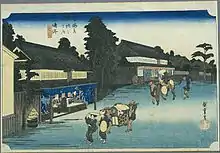Narumi-juku
Narumi-juku (鳴海宿, Narumi-juku) was the fortieth of the fifty-three stations of the Tōkaidō. It is located in former Owari Province in what is now part of the Midori-ku section of the city of Nagoya, in Aichi Prefecture, Japan.

_(1)%252C_Misara_Narumi-cho_Midori_Ward_Nagoya_2020.jpg.webp)
History
Narumi-juku had a population of 3,643 people at its peak.[1] The post station also had 847 buildings, including one honjin, two wakihonjin and 68 hatago.[1]
The classic ukiyo-e print by Andō Hiroshige (Hōeidō edition) from 1831 to 1834 depicts travellers passing by open-fronted shops selling tie-died cloth, typically used for making yukata summer kimono, which was a local speciality of the region.[2] The railroad bypassed Narumi-juku in the Meiji period, and a portion of the old town is preserved as a tourist attraction.
Further reading
- Carey, Patrick. Rediscovering the Old Tokaido:In the Footsteps of Hiroshige. Global Books UK (2000). ISBN 1-901903-10-9
- Chiba, Reiko. Hiroshige's Tokaido in Prints and Poetry. Tuttle. (1982) ISBN 0-8048-0246-7
- Taganau, Jilly. The Tokaido Road: Travelling and Representation in Edo and Meiji Japan. RoutledgeCurzon (2004). ISBN 0-415-31091-1
References
| Wikimedia Commons has media related to Narumi-juku. |
- Tōkaidō Shukuba Walking Guide. Aichi Prefecture. Accessed December 17, 2007.
- "Archived copy". Archived from the original on 2011-12-16. Retrieved 2012-01-20.CS1 maint: archived copy as title (link)
